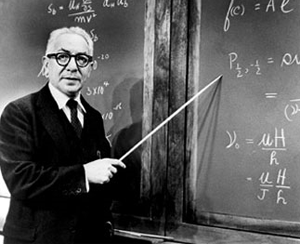Ask Alma's Owl: Restoring Rabi’s Room

Dear Alma,
Is there any truth to the story that Columbia physicist I. I. Rabi once cooked hot dogs on the cyclotron in the basement of Pupin Hall?
— Atomic Adventurer
Dear Atomic,
Yes. You can find a photograph on the Internet of this unusual culinary feat by a pioneering scientist whose research into atoms led to the development of both the atomic clock and MRI imaging. The image also appears in Robert McCaughey’s history of the University, Stand, Columbia, and in Rabi’s namesake Rabi Room on the eighth floor of Pupin Hall.
Indeed, one entire wall of Room 813 in Pupin, which served as Rabi’s office from the 1930s until his death in 1988, is filled with photos and text documenting the life of the man whose research propelled Columbia Physics to leadership in the field.
Isidor Isaac Rabi (Ph.D.’27) was born in a town in Austria-Hungary that is now part of Poland and grew up on the Lower East Side of Manhattan and Brownsville, Brooklyn, to parents who never learned English. He earned a degree in chemistry at Cornell before coming to Columbia to complete his doctorate.
“The story of Rabi’s life and career … is an inspiration both to college and graduate students in physics because of the amazing path of Rabi’s life. It illustrates that it’s important where you get to, not where you started from,” said Chauncey Olinger (GSAS’71), who conceived the idea for the room and oversaw its construction in 1996.
The newly decorated Rabi Room overlooks Teachers College across 120th Street and is furnished with a conference table, blackboard and wall monitor.
Rabi’s daughters: Nancy Lichtenstein and Margaret Beels with Chauncey Olinger in the Rabi Room.
Columbia first offered Rabi a lectureship paying $3,000 in the late 1920s at the recommendation of a young Werner Heisenberg. In 1940, Rabi temporarily left to become director of research at the Radiation Lab at M.I.T., where he helped develop radar.
Rabi played an important role in the overall wartime effort. Though he declined the offer by J. Robert Oppenheimer to become the associate director of the Manhattan Project at Los Alamos, Rabi was a consultant to him from 1943-45.
Rabi went on to win the Nobel Prize in Physics in 1944 “for his resonance method for recording the magnetic properties of atomic nuclei.” He once said that he did not think much of the Nobel Prize until he learned Einstein and Fermi had recommended him. Since it was wartime, the ceremony was not in Stockholm. Nicholas Murray Butler handed the prize to Rabi in a ceremony at Faculty House.
Send your questions for Alma's Owl to [email protected]